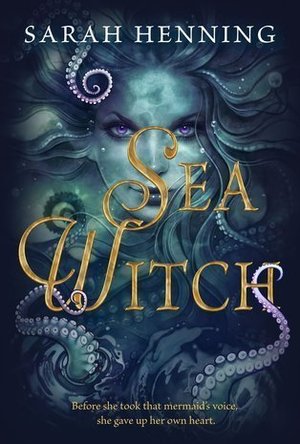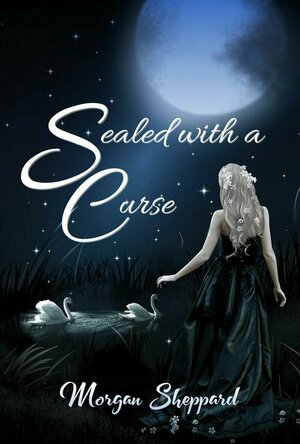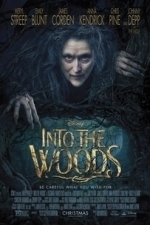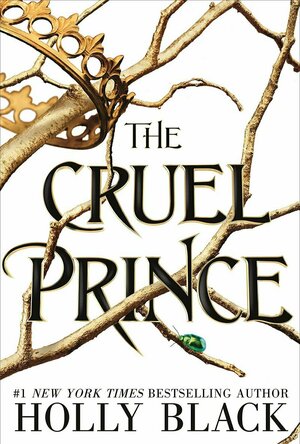Everyone knows the story of The Little Mermaid by Hans Christian Andersen, or at least Disney’s version with Ariel and her friends Sebastian and Flounder. People will also recall the evil sea witch (Disney’s Ursula) but has anyone ever wondered how the octopus-human hybrid came into being? Why is she considered evil? Why is she alone under the sea? Sarah Henning, a journalist from the US has asked these questions and come up with an answer in her debut novel Sea Witch.
The story begins on a ship many years ago in part of Denmark with the crown prince’s birthday party. Narrated by Evie, a commoner who also happens to be the prince’s best friend, the story flits between present day and four years previously when Evie and Prince Nik’s friend Anna drowned. Whilst Nik is celebrating his sixteenth birthday, Anna should have been celebrating her fifteenth, therefore, when Evie sees a face peering through the porthole of Nik’s ship, she believes it is only in her imagination that it resembled her long lost friend.
The party comes to a sudden end with a storm causing guests to flee below decks, leaving Evie, Nik and his cousin Iker to try to steer the ship to safety. In a terrible moment, Nik is swept overboard by a rogue wave and Evie fears he will be lost forever. Fortunately, Nik is found washed up on shore, but Evie is sure she saw a mermaid hovering over him.
Things become stranger for Evie when a homeless girl arrives on the beach a few days later. Claiming to have run away from home, Evie is startled by the girl’s appearance – she looks just like Anna. To make things even odder, the girl’s name is Annemette, a name so similar to Evie’s missing friend.
Evie and Annemette quickly become firm friends and both catch the eyes of the Princes Nik and Iker. With romance, Evie wonders if both girls will get their happily ever after. However, there is dark magic in the air and not everything is as true as it appears.
With a dark twist at the end, Sea Witch is a story full of magic, secrets and love. Although the blurb hints of the connection to The Little Mermaid, it is unclear until the very end what characters tally up. Unpredictable and exciting, Sea Witch is a story for those with a sense of adventure, a lover of fairytales, a romantic or a history buff, however, remember, not all fairytales have happy endings.
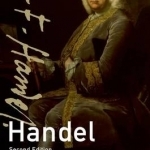
Handel
Book
Handel is one of the most remarkable figures in the history of western music. His compositions form...

jigsaw puzzle hd real games
Games and Entertainment
App
Puzzles & Jigsaws is a beautiful jigsaw puzzle game. It is a highly addictive and relaxing pastime...
Debbiereadsbook (1608 KP) rated Sealed with a Curse in Books
Sep 24, 2022
If you follow my reviews, you'll know I love the books that are steamier and smexier and sometimes more violent. This book is neither, and I loved that fact that it wasn't!
I can't write a blurby bit, so not gonna bother, but I might rave a bit!
Selene is an old soul, I think, that she can, even when faced with the escalation of the bullying from the princes, NOT want them punished in the way they are. She wanted them to LEARN from it, yes, but not to the extent it was.
I loved that the Gods these people prayed to heard them, and stepped in. Loved that they had a voice too, even it was briefly! The bickering between the Sisters was wonderful to read.
Like it said, it's not steamy, there is the bullying in the beginning though, of Selene by the eldest brothers. It does get physical. Be mindful of that if you have triggers.
There is, though, MUCH love here. Selene loves her swans (as did I!) and the people around the castle. And in time, she does come to love Conway. Who, I thought, was a bit hedgey about why he came to the castle, and i thought there was more to him that there was, but it turns out I was reading between none-existent lines there!
It's full of description, in depth descriptions of people, places, flowers, even ribbons! I loved reading those. I could picture them, you know?
I loved all the supporting characters around the castle. I want to know what's got up a certain someone's behind, though, that was never made clear!
What I loved most though, was the interpretation of this tale. I never heard of this tale before, and at the end of this book, there is a bit about various versions and how they differ. I read that, and I loved that little bit of extra info.
There is also a bit that says we might hear from the brothers again, and I really want that! It would be nice to get into their heads, especially the eldest two, NOW rather than before. To see where they are at, and what they thought of their former selves.
All in all, a wonderful read, that kept me up way past my bedtime. I loved it, I really did. Bar Disjointed Lives, this is my favourite read by this author.
5 full and shiny, moon-touched stars
*same worded review will appear elsewhere

Lonely Planet Pocket Edinburgh
Book
Lonely Planet: The world's leading travel guide publisher Lonely Planet's Pocket Edinburgh is your...
Darren (1599 KP) rated 6 Days (2017) in Movies
Jun 20, 2019 (Updated Jun 20, 2019)
England faces the idea of negotiating with terrorists or being strong and taking them down from the within showing the strength to deal with terrorist situations. As the tensions rise, Max tries to find a peaceful solution to everything while Rusty and his team are preparing for any chance of taking the embassy by force.
Thoughts on 6 Days
Characters – Rusty Firmin is the lead on a SAS team that are called to try and solve the hostage situation, they have only ever done training never being able to get their hands-on experience before. Rusty is desperate to show they are ready to protect their country. Max Vernon is the negotiator that keeps the terrorists calm, trying to make their demands happen, he stays calm through the whole situation even when the pressure to make something happen is getting to him. Kate Adie gives updates from outside for the watching television public to see how everything unfolds, in all honesty, we don’t need to be following this character.
Performances – When you look at the performances you can’t fault them because they are give good performances, Mark Strong shines like he always does, Jamie Bell is good too, the limited scenes Abbie Cornish is in she does well to. The problem is the characters are not the most interesting.
Story – The story is based on the real Iranian terrorist hostage situation in 1980 which last the 6 Days. It shows how England didn’t want a copy of what happened in Munich, didn’t want to give into terrorism and wanted to remain strong in the eyes of the world. It also shows how while being trained to deal with the situation, the SAS had never had to tackle things in reality. This should be an interesting watch but in the end, we don’t focus on enough of the negotiation process or the tactical side leaving us feeling like we haven’t learnt enough by the end.
Action/History – The get tactical action, the most part is training ideas before one main shot, but it doesn’t feel like it was shot the best way. We learn moments from the historical events, but most comes from the reading over the storytelling.
Settings – The film is set instantly around the Embassy, which puts us into the action from the start which is all we want to see.
Scene of the Movie – The practise sieges
That Moment That Annoyed Me – I feel we should have followed one side more instead of trying to cover three angles.
Final Thoughts – This is a solid enough history lesson, we learn what we need to, but not enough from the action unfolding before us.
Overall: Disappointing historical drama.
https://moviesreview101.com/2017/11/26/6-days-2017/
Gareth von Kallenbach (980 KP) rated Your Highness (2011) in Movies
Aug 7, 2019
The youngest is Prince Thadeous (film co-writer Danny McBride), he is a slacker’s slacker, a player’s player, he enjoys booze and other mind-altering stuff, he lays with easy maidens and…well, you get the point. Even though the two brothers are so very different they still love each other, even if Thadeous won’t admit it. So when Prince Fabious was to be married to the beautiful yet naive Belladonna (the enchanting Zooey Deschanel) he wanted none other than his younger brother to be his best man.
But fate had other plans and what should have been the happiest of wedding days was ruined when the evil wizard Leezar (Justin Theroux) kidnaps Belladonna so he can produce an evil dragon offspring that he would use to rule the world. The two brothers vow to save her and kill Leezar. Ok, technically Thadeous is told by their father the King (Charles Dance) that either he goes with his older brother or he will be kicked out of the kingdom and it is Fabious who does the vowing. So they ride out with their most trusted knights and along the way they meet the Great Wize (not a typo) Wizard (voiced by Mario Torres. Jr.), the highly skilled fighter Isabel (played by a pretty intimidating Natalie Portman), the Minotaur (Brian Steele, a surprisingly fitting name), forest people (I loved the forest people!). Epic adventure and treachery ensue – dun dun dunn! Will they save Belladonna and the world? Will Thadeous become a respectable prince? Will the minotaur live happily ever after?
The movie is funny but the humor is on par with middle-school-aged male humor so approximately 80% of all adult males will probably find the movie funny and a lot of wives will be wondering why they married them. It also had some decent fight scenes sprinkled throughout the movie. I’ll be honest, there were a couple of scenes in the film that I wish I could un-see… the kind of stuff that never happened in any dice role-playing game that I have ever played.
Now I am sure we have all seen movies where one person’s performance was so well done that it made the other people’s performances seem lacking (whether they truly were or not). To me this movie fell victim to that problem. After all with people like Charles Dance, Natalie Portman, James Franco, Zooey Deschanel and Damian Lewis, who plays Boremont, one of the trusted Knights, it was bound to happen. Overall, a very entertaining and funny movie.

Cosmic Cabaret
Rosalie Redd, Jayne Fury, C.J. Cade, Kat Vancil, Blaire Edens, Diana Rivis, Tessa McFionn, Dena Garson, Selene Grace Silver, Cailin Briste, Athena Grayson , Jenna Lincoln and Kerry Adrienne
Book
Where Hearts Collide in the Greatest Show in Space Join us aboard Blue Star Line’s crown jewel,...
Science_Fiction Romance Anthology
Movie Metropolis (309 KP) rated Into the Woods (2014) in Movies
Jun 11, 2019
However, musical movie adaptations are notoriously difficult to get right, from casting restraints to the inclusion of all the songs, transferring them to the silver screen is not something to be entered into lightly. So does director Rob Marhsall’s effort elevate itself above its peers?
Into the Woods has numerous plot threads that all end up coming together in one way or another, but the main storyline follows a baker (James Corden) and his wife, played gloriously by Emily Blunt, as they come to realise they cannot have a child.
Alas, a witch – who just so happens to live next door – has a way to provide them with what they want as long as they get a few items for her in the meantime.
An all-star cast including the likes of Chris Pine, Anna Kendrick, Christine Baranski, Lucy Punch, Johnny Depp and of course Meryl Streep all give their all in a film that is brimming with tantalising cinematography and stunning songs.
meryl-streep-into-the-woodsGenerally speaking, the female cast fares better in the singing portions of the film, although Chris Pine and Billy Magnussen had the audience in intentional fits of laughter in one particular sequence as two handsome Princes.
Unfortunately, Into the Wood’s greatest asset, its cast, is also its biggest undoing. Having so many story threads means that there isn’t any emotional attachment to the characters – despite the film’s numerous attempts to tug at the heartstrings.
Despite a deeply heartfelt performance of ‘Stay with Me’ from Meryl Streep, the film just steadily rolls itself from admittedly thrilling set piece to set piece without getting bogged down in nitty gritty character development.
Thankfully, the glorious cinematography that featured in the trailer continues throughout. An enclosed feeling makes you feel like you’re actually watching a stage show rather than a film, albeit one with a much higher budget, and this is one of its most captivating features.
Director Rob Marshall has managed to keep the pantomime feel despite the fact the audience is watching in a cinema – the locations are never overdone and everything feels nicely claustrophobic, adding to the eerie atmosphere.
However, the final act is unnecessarily long and its foray into deeper territory means the magic and sparkle is well and truly lost. This is a real shame as there are numerous moments where the film could end on a high, rather than delving into a murky and at times, incomprehensible final third.
Overall, Into the Woods is a charming adaptation of the popular musical and despite its slightly overlong running time and a disappointing final act, it manages to stay on course for a perfectly adequate, if underwhelming finale.
The entire cast have a ball with their characters with Meryl Streep and Emily Blunt being particular highlights throughout.
Parents beware however, its PG certification may be slightly too lenient for smaller children, who will no doubt be intrigued by the premise of combining our most-loved fairytales.
https://moviemetropolis.net/2015/01/17/a-charming-adaptation-into-the-woods-review/
postapocalypticplayground (27 KP) rated The Cruel Prince in Books
Mar 12, 2018
However, after the first 8 chapters the story moves from High School drama to something more fantasy based, Jude finds herself tasked with an unusual role which she hopes will find her favour within the court (Tarryn gets reduced to wanting to be a good little wife to a high lord – urgh) and ultimately secure her a role in which she will win respect. Jude must learn to become tough, to learn secrets and to ultimately become a pawn in a much larger game for power. Despite my reservations Holly Black worked some magic on me that led me to not want to put the book down, there were twists and turns, truths and lies, and a plot that left me reeling, if not a little confused sometimes. It’s a book that feels like it is trying to be many things, there is one scene that feels particularly Game of Thrones esq, but it does for the most part mange to keep it’s own identity.
I have struggled to write this review and I did hover between 2 and 3 stars for a long time, I have decided on 3 as for about 2/3 I did actually enjoy the underlying story, if not the characters themselves. I found it richly woven with plenty to keep me thinking ahead and an intriguing back story. There are a number of games in play and lots of clues of being dotted around, unfortunately Jude is too caught up to put the pieces together properly which isn’t surprising as even I was struggling to keep up with all the things going on! Despite myself, I will probably read book 2 as for some reason that I can’t entirely fathom I really want to know what happens next, perhaps it’s a glamour from the pages themselves…….
